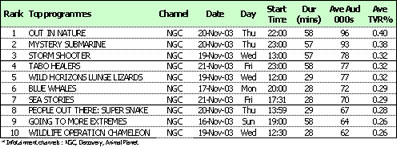MUMBAI: The TRP war has spilled over to the infotainment channels as well. While these niche channels bag a small portion of the ratings pie, they are quite crucial in decision making segment, grabbing as do quite a few of the SEC A, B eyeballs.
While Star's infotainment arm National Geographic Channel (NGC) issued an ad recently in leading dailies claiming its right to the top spot, One Alliance's Discovery Channel has shot down the claims with a 25 page riposte armoured with graphs.
Ads in a leading daily last week had claimed that NGC has captured almost 74 per cent - the lion's share - in the TRP pie amongst the three infotainment channels: NGC, Discovery and Animal Planet.
While Animal Planet (sibling of Discovery), according to the supplied TAM data for week ended 22 November 2003, (4+ ABC with C&S- six metros), grabs a minuscule two per cent share, closest competitor Discovery nets 24 per cent share. NGC, in the ad, also claimed that it has 10 out of the top 10 programmes and 37 of the top 50 programmes in its genre. The ad proclaims it to be 16 places ahead of Discovery in channel ranking based on all India shares.
Quoting TAM data, the channel also claims it has bagged the numero uno position with the help of blockbusters like Egypt, Mission Everest and Secret Unveiled.
 Speaking to indiantelevision. com,NGC's assistant vice president - marketing, India, Puneet Johar offered, "Last quarter was very good for us. Our average share for October and November was 0.45 against Discovery's 0.38 and Animal Planet's 0.21.
Speaking to indiantelevision. com,NGC's assistant vice president - marketing, India, Puneet Johar offered, "Last quarter was very good for us. Our average share for October and November was 0.45 against Discovery's 0.38 and Animal Planet's 0.21.
Elephant Family: Bonds of Life, which was aired on 11 November 2003 at 12 pm, tops the chart for this quarter. The programme garnered a TVR of 1.8 per cent with a reach of 2.7 per cent."
When asked, Discovery Communication India's marketing director Aditya Tripathi offered: "We are not worried about the selective data pictured in the ad. The data presented in the ads is only for a week and that too for selective six metros. In fact if you take a look at the programmes in the list, they are all one minute fillers. By definition, fillers enjoy greater ratings as you just require audience to flit through. But is it the case of filling up the slot when you don't get enough ads?"
"It is unfair to slot Discovery in the niche infortainment channel slot, the data that we have gathered from TAM clearly indicates that we often not only compete but also lead the English channels pack, " he said.
In its year ender report released recently, Discovery has managing director Deepak Shourie quoting TAM S Group data collated in the month of August and October, claiming that Discovery has not only succeeded in bagging the top position in the infotainment genre, but is also ahead of movies and news channels.
Quoting TAM S-group data and NRS data, the report claims that the 'channel commands the highest viewership in important demographics like upscale men and women'. Comparing data with the likes of Star movies, HBO, Zee MGM, Zee English, Star World, ESPN, AXN, MTV, Channel [V], NDTV 24X7, CNBC, CNN and BBC, the report says TAM August-October data shows that the channel has a higher reach and the highest viewership.
With a meticulous approach, the Discovery yearender tries to establish its supremacy both in terms of size, profile, intensity of viewing, media optimiser, unique viewers, stability and value of audience.
"In fact, we have almost achieved 25 per cent growth over last year. With new launches scheduled for the first quarter of 2004, things are bound to be better, " adds Tripathi.
So, what's the real picture here? Let's take a look at the history - Discovery launched on 15 August 1996, followed by National Geographic Channel in September 1999 and Animal Planet hitting the tube on 29 March 2000. So, in a sense, Discovery has a first mover's advantage, plus it has been an established channel overseas since 1985 as opposed to NGC's 1991 launch.
With its India specific programming slots and more than just a 'nature programming' line-up, Discovery definitely grabs a huge chunk of the eyeballs. But like mentioned in the data, NGC manages to march ahead sporadically, especially with its reality shows and its interstitials, albiet in the metros. For instance, the show Mission Everest helped NGC steal a march over Discovery. According to TAM data, National Geographic moved ahead of Discovery channel across six metros, grabbing 0.7 per cent of viewers while Discovery garnered 0.5 per cent, between June and August 2003, when Mission Everest aired.
While the jury is still out on this one, what is clear is that while Discovery is the leader in the 'infotainment' genre, the competition is picking up. Take the instance of aviation day specials on both channels. While Discovery had three day specials, NGC rivalled with an evening of aircraft bonanza. With The History Channel now being part of the Star brigade, NGC has an complimentary partner something, which One Alliance's Discovery should take serious note of. As of now, it's over to Discovery.






